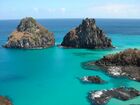Earth:Tied island
Tied islands, or land-tied islands as they are often known, are landforms consisting of an island that is connected to the mainland or another island only by a tombolo: a spit of beach materials connected to land at both ends. St Ninian's Isle in the Shetland Islands off the north coast of Scotland is an example since it was once an island but is now linked to the mainland.
Other examples include Maury Island, Washington (state) in the Puget Sound, Coronado, California , and Nahant, Massachusetts in the United States ; Paraguana Peninsula in Venezuela; Barrenjoey, New South Wales and Wedge Island, Western Australia; Paratutae Island in New Zealand; Mount Hakodate in Japan , Howth Head in Ireland; Davaar Island, Campbeltown, Scotland; Chefoo island in Yantai, China ; and Cheung Chau in Hong Kong.
The Isle of Portland, in England , is also described as a tied island, but geographers now believe that Chesil Beach, which connects the island to the mainland, is a barrier beach that has moved eastwards, rather than a tombolo, which would have been formed by the effect of the island on waves.
Paniquian Island, also known as Isla Boquete, is a small tied island in Puerto Galera, a popular tourist destination in the Philippines . The island is connected to the main island of Mindoro by a small tombolo, which is submerged only a few times per year.
See also
- Presque-isle (from French for "almost island")
- Tidal island
References
- Glossary of geology and related sciences. Jesse V. Howell, American Geological Institute. 1962.
- Some Coastal Landform Definitions. Matthew Flinders, Villanova College, Queensland.
External links
 |





